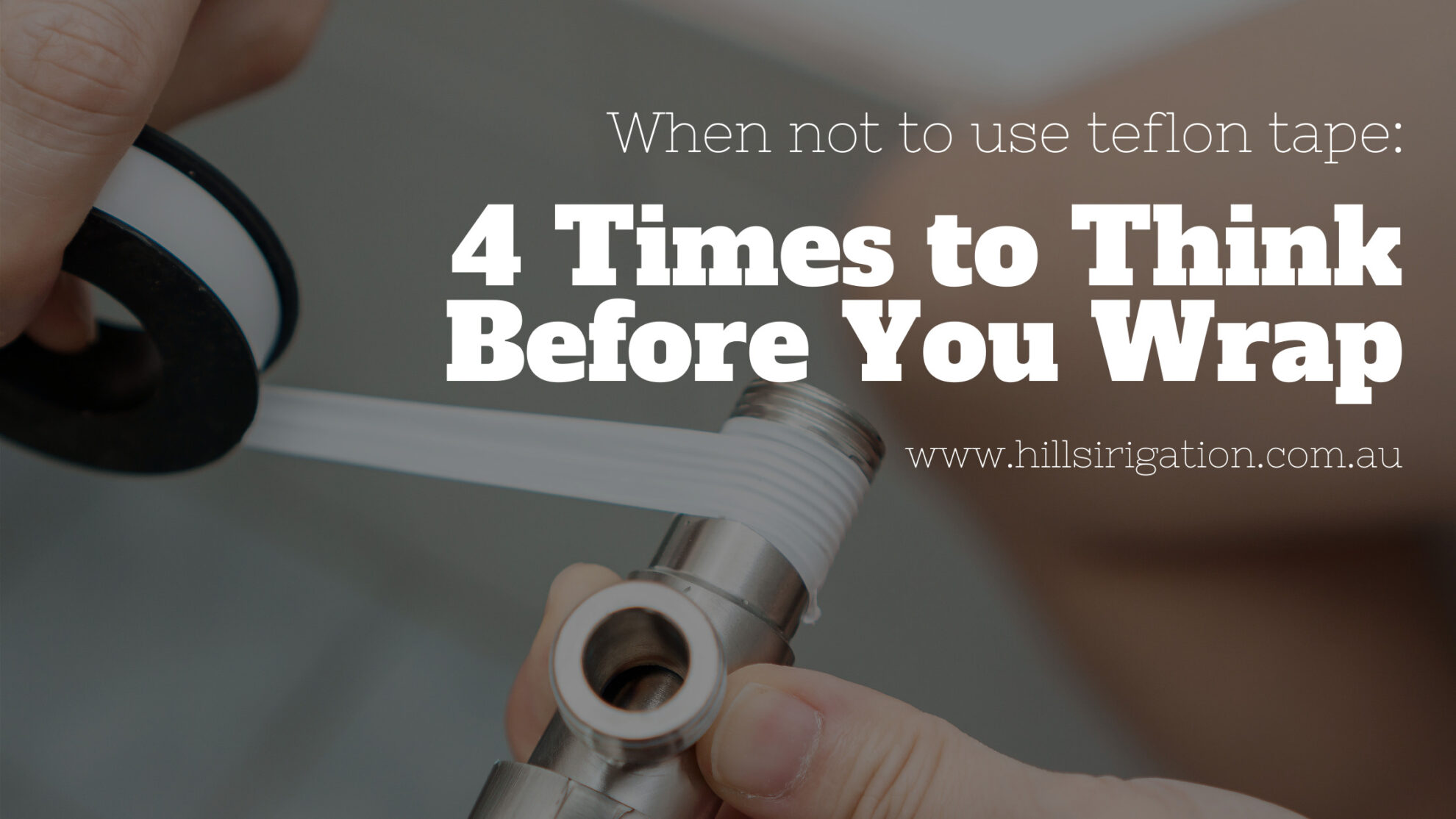
Often referred to as a plumber’s best friend, Teflon tape or thread sealant is a simple yet effective material found in tradie toolkits worldwide. Also known generically as PTFE tape, it’s generally used as a sealant and lubricating material, perfect for installing fittings in the kitchen and bathroom. In fact, it’s essential to use thread tape for those household brass fittings unless a rubber seal or gasket is in place.
Outdoor applications are also common, from tankless water heaters to irrigation systems and garden taps. In essence, PTFE tape comes in handy whenever you need a sturdy material to help tighten and seal pipes to avoid leaks. And it’s not just for plumbers, either – almost all households will need some of this handy tape sooner or later.
The question is, though, do you know when and when not to use Teflon tape? This is a critical factor if you’re planning to use Teflon tape for a DIY project, since Teflon tape can actually cause leaks if misused. For example, if you’re working on PVC, copper or PEX pipes, these use alternate bonding methods and Teflon tape isn’t necessary.
Keen to find out more about when to use plumber’s tape? We’ve rounded up all the need-to-know information on when to use PTFE tape (and when you should definitely give it a miss). With many kinds of tape for plumbing and irrigation on the market, it’s important to know when to use each one.
Table of Contents
What is Teflon Tape (PTFE tape)?
PTFE tape – often referred to as “plumber’s tape” or “Teflon tape” – is a professional strength adhesive tape used in a variety of applications, usually involving ductwork or piping. You can find it in your local hardware store where it is usually sold in varying sizes, from small rolls to big spools. To better preserve the adhesive, plumber’s tape often comes inside a plastic casing.
PTFE is short for polytetrafluoroethylene, and what makes it so useful is that it’s hydrophobic (water repellant) and has very low friction. This makes PTFE tape a must-have for plumbers and anyone who does pipework jobs, such as irrigation contractors. Every plumber worth their salt should have teflon tape with their other irrigation tools.
Although PTFE tape is most commonly referred to as ‘Teflon tape’, Teflon is actually a brand name of the PTFE material. Interestingly enough, the manufacturer of Teflon, DuPont, has never made its product in tape form. Other tape manufacturers used Teflon to create their plumber’s tape, and they were allowed to use the name as long as they are using real Teflon in their products. So, while it is a popularly used term, it’s not always accurate – your tape may contain another brand or variety of PTFE not associated with the Teflon trademark.
Instead of calling it Teflon tape or plumber’s tape, you can also specifically ask for:
- thread sealant
- thread seal tape
- thread-sealing tape
- PTFE tape
All of these terms refer to the same types of irrigation tape. Still, Teflon tape and PTFE tape are acceptable, interchangeable terms. You’ll still be handed the right item at the hardware store, whichever you choose.
What is Teflon Tape Used For?
Standard PTFE tape is quite versatile and is used to seal water, gas, and air from leaking through threaded connections, most effective on high-pressure lines. However, there are also specialty thread seal tapes geared towards a specific task or need. To make choosing a specialty thread seal tape easier, they come colour-coded for the type of application each one caters to. Generally, however, specialty thread seal tapes are much denser and thicker than the standard version.
Keep reading for our handy guide on thread seal tape colours and their meanings.
Types of PTFE Tape & Common Usage
White – Basic Thread Seal Tape
White is the standard colour for thread sealant tapes and it is recommended for basic plumbing jobs. Most households probably have a roll or two of white Teflon tapes, as it’s an all rounder and good to use for less-critical, non-professional jobs. It is still sturdy with all the features of PTFE: high resistance to most chemicals, high resistance to extreme temperatures and can tightly seal threaded pipe connections.
Pink – Thread Seal Tape For Water Lines
Colour-coded for water lines, pink thread sealant tape is used by pipefitters and plumbers. As such, it is very heavy duty compared to the other standard type of tape.
Yellow – Thread Seal Tape For Gas Lines
Yellow thread seal tape meets all gas company standards for gas lines of all types, be it butane, propane, or natural gas. It’s important to use the right thread seal tape for gas, and the yellow variety is the only safe choice.
Green – Thread Seal Tape For Oxygen Lines
Green thread seal tapes are required for oxygen applications, as it is grease-free yet does not allow fires to start.
Grey – Thread Seal Tape For Stainless Steel
Grey thread seal tape has a high-density rating and is nearly double the thickness of standard thread seal tapes, making it ideal for taping up stainless steel threads, preventing seizing and galling.
In short, thread seal tape is best used to seal up most threaded connections. However, if said connection has a rubber seal or gasket, you also do not need thread seal tape.
How To Use Thread Seal Tape Correctly
While thread seal tape is not difficult to use, it is not as simple as slapping on some good old duct tape and calling it a day. The way it is applied is vitally important, not only because incorrect application will fail to keep your connections and pipes watertight, but taking off wrongly applied thread seal tape so you can re-apply it can be a major pain.
The first thing to consider is to wrap it around the pipe in the correct direction. If you do it right, the pressure from the mating threads should end up tightening the tape around the pipe. Wrap it wrong, and the threads will work against it and ball it all up.
The trick is to wrap the tape in the opposite direction that the pipe is to turn. Follow these steps for the proper usage of thread seal tape:
Step 1: First, make sure that the ends of your pipe are clean and dry.
Step 2: Place the end of the thread seal tape on the second thread from the end of your pipe and keep it stationary with your finger.
Step 3: Begin wrapping the pipe in the opposite direction the pipe will turn, keeping the tape tense so that you can wrap it tightly onto the threads.
Step 4: How many times the thread seal tape will go around the pipe depends on the thickness of the tape, but for the standard variety, about five or six wraps should be enough for the job.
Step 5: When done, simply grip the tape tight and give it a strong tug. Simply smooth out the remaining loose tape onto your pipe, and you are done.
Alternatives To Teflon Tape
While using thread seal tape is great in most cases, unfortunately, there are some occasions where it is not the ideal tool for the job. Some pipes have wide threads, which causes water to dribble through. In other instances, the opposite problem can exist, where the pipe will not give you enough room to properly apply the tape.
Also, the threads of the pipe you are trying to seal may have suffered some damage or wear and tear, which would make it very difficult for thread seal tape to create an air- or water-tight seal.
In situations like these, you will need to look for suitable alternatives to thread seal tape to get the job done.
“Pipe Dope”
For many of the same applications, thread seal tape can be substituted with a pipe joint compound, commonly called “pipe dope.” Composed of a complex mix of materials (including oil, clay, ethanol and rosin) to create a liquid, pipe dope serves as a lubricant and a sealant for threaded joints. It usually comes with a small brush to apply the compound with.
Like thread seal tape, there is a general use or universal variant of a pipe joint compound; but there are also types that can only be used for a specific type of pipe, such as metal or plastic. Some pipe joint compounds may also not be suitable to use on water or gas, for example. Make sure you read the directions on the product carefully.
Some plumbers and other workers use both these products in the same application, adding a thin coat of a pipe joint compound over the thread seal tape to insure a watertight or airtight seal.
Teflon Valve Packing
Another alternative to thread seal tape is Valve packing, which is another form of Teflon. It’s used as an alternative for O-rings as it acts as a gasket or bushing, ideal for connections that come with large gaps or with a ridge.
One popular question on the subject of Teflon tape alternatives is if silicone sealing tape can be used as a substitute for Teflon tape. Most careful plumbers do not recommend using silicone due to its low resistance to corrosion and poor lubricating characteristics. Teflon tape is so fantastic because it does just the opposite!
So when you’re deciding whether to use Teflon tape for your next DIY project, always consider the type of material, type of fitting and whether there are any other factors keeping PTFE tape from successfully sealing the connection.
Related Questions:
Can too much Teflon tape cause leaks?
If you use too much Teflon tape, this can crack the female adapter, leading to a leaky fitting. On the other hand, if you don’t put enough, the pipes can also leak. Expert plumbers advise to use just the right amount – not too much, not too little, even if it’s easier said than done. Our tip is to always inspect your work to ensure that you have tightly covered the entire length of the threads evenly and consistently.
How many times should Teflon tape be wrapped?
Typically, 2 – 4 wraps of thread seal tape are sufficient but, you also want to make sure you are giving your wraps a nice, tight tug. After hand-tightening, you can use channel locks (or something similar) to tighten further.
Disclaimer:
This article is published for general informational purposes only and does not constitute professional advice. Any action you take upon the information you find on this website is strictly at your own risk. Always ensure you have the right qualifications and certifications to carry out DIY work and never put your safety at risk. Hills Irrigation recommends consulting a professional for all electrical and plumbing work.

Vince is Managing Director of Hills Irrigation and is supported by Lisa in an administrative capacity. Andrew, Isaac and Megan look after the day to day needs of both online and shop customers. As Project Manager, Vince is also responsible for installation projects along with his team. It is his responsibility to work closely with clients to ensure that scope of work is understood and followed.








